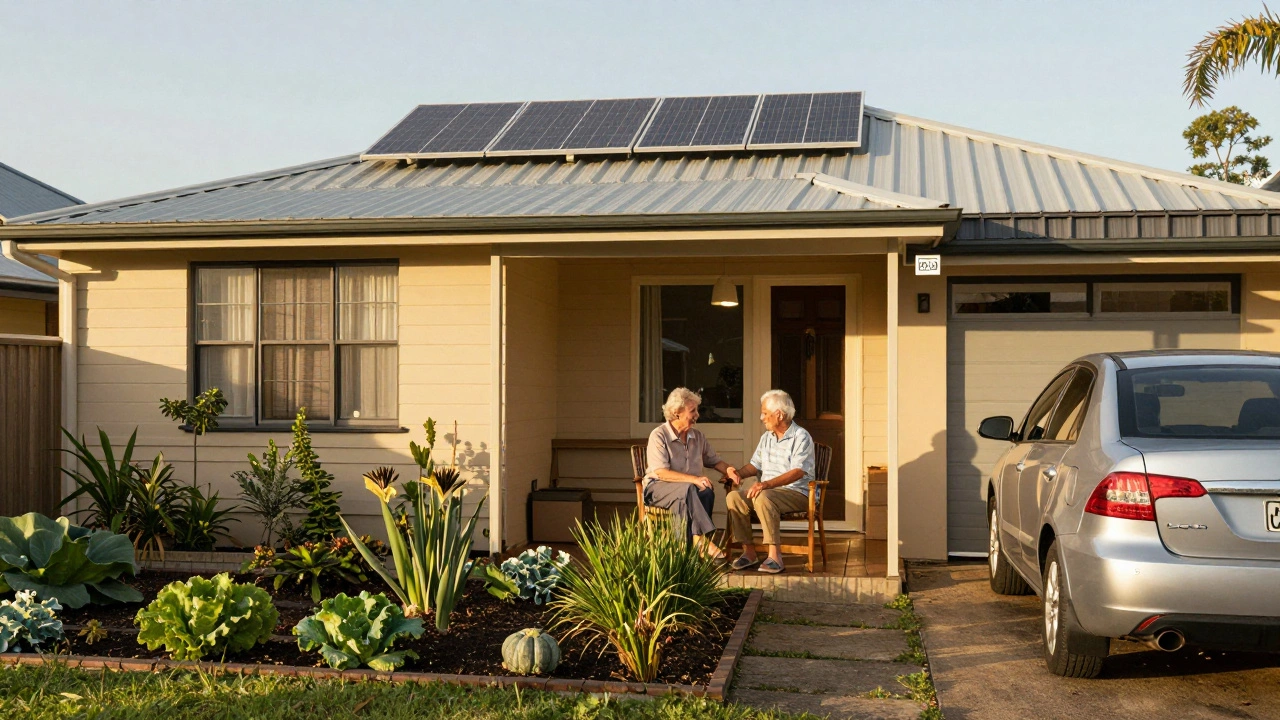Picture this. The first major summer storm hits Brisbane, wind howling, debris flying, and you’re eyeing the roof tiles like a hawk. You think, “No sweat, my home insurance has my back.” But imagine if it didn’t. The biggest shock about homeowners insurance? It doesn’t cover everything – not even close. Every year, thousands of Aussies file claims only to get a spine-chilling rejection letter. Why? Some risks just aren’t included. And no one checks the fine print until something nasty happens. So, what’s off the menu? Let’s get straight into the stuff your policy might just snub, and why it matters for everyday folks in Australia.
Common Myths: What Homeowners Insurance Actually Covers
It’s tempting to believe the golden promise: your policy will handle any nasty surprise that hits your Queenslander. Most people only glimpse the good bits—the fire protection, the burglary payouts, the peace of mind during storms. Truth is, many standard policies only cover named events, not everything that could go wrong within your four walls.
Let’s clear up the basics. Australian homeowners insurance usually divides into two key covers: building and contents. Building insurance covers the structure (think: walls, roof, fixtures). Contents protects your stuff inside (like TVs, your couch, your prized coffee machine). Sometimes they’re bundled, sometimes not. Both work on a common foundation—listing what’s actually covered, and more importantly, what’s not.
This is where the confusion creeps in. Not all accidental or unexpected damages qualify. For example, a mate’s broken window after a wild footy night probably isn’t covered. If the floodwaters rise, storm or not, there’s fine print behind whether your claim gets the green light. Fires are usually covered. But say your wiring’s dodgy because you did DIY repairs last summer? That’s trouble—the insurer can say it’s poor upkeep. So while insurance is a financial lifesaver when genuine disaster strikes, it’s no magic safety net. There are blanks in the coverage map, and they can cost you dearly.
Here’s a wild stat: In 2023, the Australian Financial Complaints Authority (AFCA) reported that 1 in 5 home insurance complaints revolved around disputes over what’s covered. You’re not alone if you’re confused. The sneakiest gaps in insurance aren’t hidden, but are easy to overlook because insurers expect you to read everything, even the mega chapters in the Product Disclosure Statement.
The Big No-Gos: Events and Items Most Policies Refuse to Cover
Let’s talk specifics. Not everything that breaks gets a rescue. Homeowners insurance policies have a bunch of general exclusions that catch people off-guard. You’ll probably find these sitting in the last few pages of your policy, buried under a flood of legal lingo. But look close, and you’ll spot the patterns every year.
- Floods: This is a biggie, especially in Queensland or Northern NSW. Standard home insurance doesn’t always cover flood damage, especially from rising rivers—unless you specifically add it, and it’s often pricey. Water damage from sudden bursts, like washing machine leaks, is usually fine. But rivers bursting their banks? Read carefully before assuming you’re safe.
- Wear and Tear: Insurers expect routine upkeep—if your roof leaks because you ignored it for years, that’s on you. Policies won’t bail you out for problems down to neglect, gradual deterioration, or ageing infrastructure.
- Termites and Pest Damage: Found creepy-crawlies gnawing on your foundations? That’s not usually covered. It’s seen as preventable with regular inspections, so you’ll have to pay the pest guy out of your own pocket.
- Business Activities: Renting out your spare room for Airbnb? Hosting a home salon for your mates? Most standard policies will exclude damages or losses from business activities conducted at home unless you’ve declared it.
- Acts of War or Nuclear Events: Sounds dramatic, but insurers have to draw the line somewhere. Claims resulting from war, terrorism, or nuclear incidents are flat-out excluded in every Australian policy I’ve ever seen.
- Deliberate Damage: If someone who lives in your house damages your stuff on purpose, insurers won’t pay. There can be cover for malicious acts like burglary, but not when your own teenager smashes your TV in a fit.
More surprises? Yes. Policies often skip out on ‘matching items,’ like when new tiles don’t match your original bathroom after repairs, leaving you with a polka dot effect. And when it comes to “acts of God” or unpredictable incidents, the fine print matters more than the marketing brochure.
Here’s a handy table to summarize the most common exclusions Australians report to the AFCA, based on last year’s trends:
| Excluded Event/Item | Details |
|---|---|
| Flood (from rivers/creeks) | Often not covered by basic policies |
| Termite/Pest Infestation | Almost never covered |
| Wear and Tear | Regular ageing, rot, rust, etc. |
| Unoccupied Homes | If vacant >60 days, cover usually suspended |
| Business Use | Excluded unless specifically added |
| Earth Movement | Subsidence/landslip sometimes excluded |
| Poor Maintenance | Lack of upkeep, ignored repairs |

Surprising Hidden Exclusions: The Devil’s in the Details
Now, let’s move from the obvious to the sneaky. Insurance providers have gotten creative with wording, so exclusions sometimes pop up where you least expect them. Not many people know that if your home is unoccupied for more than 60 consecutive days, most policies suspend or greatly limit their coverage. If you take that 2-month Europe trip, you might come back to a voided policy if something goes wrong at home.
Mould remediation is another classic tripwire. Water leaks generally are covered if they’re sudden and accidental, but if the insurer thinks the water sat around for a while or the mould’s been growing undisturbed, they’ll probably say it’s a maintenance issue and reject your claim.
Jewellery and collectables only get covered up to strict limits unless they’re listed separately. Got a $10,000 engagement ring? If you haven’t specified it in your policy and provided extra paperwork, your payout could be capped at $1,000, even if it’s stolen in a break-in.
Another one that stings: matching carpet or tiles. If a section needs replacing after a kitchen mishap, the policy will usually only pay to replace the damaged bit—not the entire floor. If your replacements don’t match, you just have to live with it or pay out of pocket. That's a scenario I’ve heard from countless Brisbane homeowners dealing with after-flood repairs.
Policy limitations even appear with high-end electronics. Some put strict limits on things like laptops and cameras. If you work from home and keep pricey gear there, check your policy—standard coverage can fall far short. You might need to bump your limits or buy add-ons called ‘portable valuables cover’ so your gadgets don’t get excluded if disaster strikes.
The lesson? The homeowners insurance wording hides nuances even your broker might miss the first time. If you live in a bushfire zone or close to the coast, exclusions for ‘actions of the sea’ or ‘settling soil’ could leave you stranded. Always pry into the Product Disclosure Statement with a fine-tooth comb and ask loads of questions about the specific exclusions before you sign up. It's boring, but boring beats bankrupt.
Major Tips: How to Avoid Nasty Surprises When Claiming
So what’s a practical Aussie supposed to do? If you’re like me, you want a simple life—no drama, no nasty insurance shocks. Here’s how to keep things clean and clear, so you’re never left stranded when you need that payout most.
- Regular Maintenance Matters: Insurers expect you to keep your home in good nick. Schedule periodic roof checks. Clear out gutters before storm season. Even small lapses let insurers wriggle out of claims on the grounds of ‘lack of maintenance’—the most common reason for claim denial in Australia for the past three years, according to major insurance complaints bodies.
- Know Your Policy Limits: Find out exactly how much you’re covered for on particular items. If you own high value stuff, like rare vinyl records or gold jewellery, list them separately and pay the extra premiums. The payout caps for unspecified items are usually way lower than you expect. No one wants to get $750 for a $5,000 guitar stolen out of the lounge room.
- Add Flood or Disaster Cover if Needed: If you live near water or bushland, don’t assume “storm” includes “flood” or “bushfire.” Each has a different insurance definition. It costs extra but is always worth asking about. Flood cover is one of the most rejected claims in Queensland, especially after last year’s wild weather.
- Double-Check Business Use: If you’ve turned a side hustle into a regular deal, flag it with your insurer. Many people get stung after renting out a room, offering workshops, or even running an Etsy store from their kitchen. Without a policy that covers business activities, you’re exposed.
- Document Everything: When making a claim, the more documentation you have (receipts, photos, serial numbers), the smoother your claim. Insurers will jump on any missing paperwork as a reason to reduce or reject your payout. Aussie consumers who provided complete receipts faced up to 80% fewer claim rejections in 2023 than those who didn’t, according to AFCA stats.
- Read Every Update: Insurers love to tweak policy wording quietly at renewal time. Always read each new Product Disclosure Statement—policies changed dramatically after the 2022 floods, and many folks got caught out by small print updates they didn’t spot.
One quirky tip? If you’re going away for over eight weeks, let your insurer know and, if possible, have someone check on your home. Some insurers will reduce your risk and keep the full policy valid if the place isn’t totally abandoned. That’s a small move with big peace of mind.

Real Scenarios: Common Claims and Why They Got Denied
Stories speak louder than any checklist, right? Let’s go through a few frustrating cases straight from local experiences—these tales explain why knowing what’s not covered is as important as knowing what is.
Take my mate Ian: He was on holiday when storms battered the tiles off his back room. He came home to buckets of water and a mushroom colony in the carpet. He called his insurer, thinking it’d be sorted. The kicker? Since the leak had gone undetected for ages and the house was empty too long, they turned him down cold. The small print said “occupied and maintained premises only.”
Or there’s Rachael, who found termites ticking away inside her kitchen wall, only to learn pest damage isn’t insurable. She’d thought regular contents insurance had her covered but pest attacks are considered preventable.
Sam’s Home Office Disaster: With remote work on the rise, Sam decked out his spare room as a full studio, but never flagged this business use with his insurer. When a fire triggered by a surge bar torched his gear, the insurer voided the claim. Business-related losses weren’t on the basic policy.
Here’s a story about lost jewellery. Laura had her grandmother’s ring stolen in a break-in, worth more than $15,000. She had home insurance, but didn’t specifically list the ring or update her coverage. The result? A payout capped at $1,500. She learned the hard way: always update your valuable items with your insurer.
Then there’s the ever-problematic flood claims. After the Queensland floods in 2022 and again in 2024, massive numbers of claims were denied because insurer definitions of ‘flood’ are rigid—only covering stormwater, not rising river water, unless you’ve paid for the separate ‘flood’ add-on. Over 40% of denied complaints to the AFCA in 2024 related to this muddled definition.
These real-life blunders show that not knowing the exclusions can burn a big hole in your savings. Don’t leave it to chance—dig into the fine print now, not after disaster strikes.
Insurance is a must, but the truth is, your homeowner’s policy has limits. Knowing what’s not covered gives you a genuine edge—helping you plan better, avoid costly mistakes, and go to sleep when big storms hit, knowing exactly what’s looked after (and what needs your own back-up plan). If you’re ever unsure, call your insurer before you wake up to a nasty claim rejection. Your furry mate Jasper might sleep through the drama, but you’ll want to be ready for anything the wild Aussie weather (or life) throws at you.








